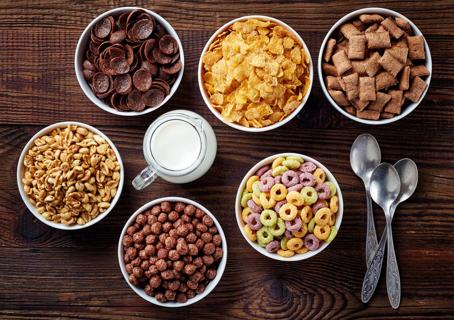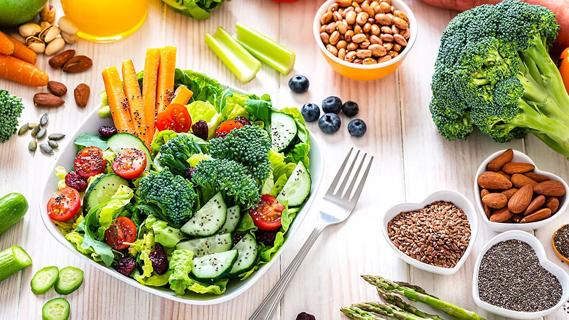Nutrition labels explain a product’s calories, fat content, nutrients, vitamins and more

Grocery runs can be chaotic, especially if you’re winging it and trying to eat healthy. Luckily, products have nutrition labels on them that explain important information about what you’re eating and the kinds of ingredients they contain. If you know what to look for, the process of finding healthy foods for your diet can be made easier.
Advertisement
Cleveland Clinic is a non-profit academic medical center. Advertising on our site helps support our mission. We do not endorse non-Cleveland Clinic products or services. Policy
Registered dietitian Kayla Kopp, RD, shares how to read, understand and use nutrition labels to make healthy food decisions in just seven easy steps.
Nutrition labels — those small, rectangular boxes printed on packaged foods and drinks — are meant to be helpful tools for making healthy food choices. But there are a lot of nutrition facts to digest in that little box. Knowing what to do with the information can prove challenging, says Kopp.
The U.S. Food and Drug Administration (FDA) revamped the nutrition facts label in 2016. The goal: To help people more easily find information about what they’re putting into their bodies.
Manufacturers had until 2021 to update their labels, which is why you might be noticing the changes now. Even with the new look, figuring out how to read nutrition labels can still be a bit tricky.
“The information on nutrition labels can help you better understand the impact a food or drink has on your health and diet goals,” says Kopp.
She offers these helpful tips on the following seven items you’ll find on a nutrition label:
Serving size refers to the amount of food or drink you typically consume. For example, a serving size could be 15 crackers, 1 cup of yogurt or an 8-ounce bottle of soda. Not understanding or misreading serving size is one of the top mistakes people make when reading a nutrition label, says Kopp. The nutrition label also shows the total number of servings in a product.
Advertisement
What to keep in mind: The serving size provides the foundation for the rest of the nutrition label — and this is where it can get tricky. “People underestimate serving sizes,” states Kopp. “Unless you’re counting the actual number of crackers or using measuring utensils or food scales, you’re probably eating more than one serving.” Kopp recommends measuring your foods and drinks for a few weeks until you feel confident estimating portions.
“Calories are a measurement of the energy a food or drink provides,” explains Kopp.
Nutrition labels are based on a 2,000-calorie daily diet. But calorie needs vary greatly depending on a person’s age, sex at birth, height, weight and activity level. Because many Americans these days are watching calories to lose weight or maintain a healthy weight, you’ll see the calories highlighted in BIG BOLD PRINT at the top of the nutrition label.
What to keep in mind: A product’s serving size affects its calorie count. “Let’s say there are three servings in a package of cookies. If you eat the whole package, you’ve eaten three times the number of calories listed on the nutrition label,” says Kopp. In general, a food with about 100 calories per serving is a moderately caloric food that fits into a healthy diet. Try to avoid or limit high-calorie foods that have 400 or more calories per serving.
Fats, carbohydrates and proteins are the three main macronutrients in foods and drinks. They give you energy, build muscles and help absorb vitamins.
What to keep in mind: Certain types of fats and carbohydrates are healthier than others. Here’s what to pay attention to, for each of the above:
“Focus on the amount of saturated fat in a food rather than the amount of total fat,” advises Kopp.
That’s because a diet high in saturated fats can contribute to heart disease. Saturated fats occur naturally in meat and dairy products. They’re also in coconut oil, palm oil, certain snacks and baked and fried foods. People following a 2,000-calorie daily diet shouldn’t eat more than 20 grams of saturated fat per day.
The nutrition label breaks down carbohydrates, or “carbs,” into dietary fiber, total sugar and added sugar.
Advertisement
Unless you’re recovering from an injury or trying to build muscle, you can skip the protein section of a nutrition label, says Kopp. If you’re recovering from an injury or trying to build muscle, you’ll want to talk to your doctor to determine the amount of protein you should consume on a daily basis.
“There’s nothing unhealthy about protein,” she says. And it’s rare to eat too much protein. Plus, protein helps you feel full longer. Kopp recommends aiming for 20 to 30 grams of protein per meal.
As long as you pay attention to the saturated fat number on the nutrition label, cholesterol is another section you can skip. “Most foods that are high in dietary cholesterol are also high in saturated fat,” says Kopp.
What to keep in mind: Your body makes all the cholesterol it needs, so there’s no reason to get “extra” from meats or dairy products. If you want to track this number, the recommendation for someone on a 2,000-calorie diet is less than 300 milligrams of cholesterol per day.
Sodium is an electrolyte that balances fluids in your body and helps your nerves and muscles work well. But too much sodium can lead to high blood pressure, strokes and kidney damage. According to the FDA, most Americans consume about 3,400 milligrams of sodium every day — that’s 1,100 milligrams more than the recommended amount.
Advertisement
What to keep in mind: Kopp recommends keeping sodium intake to less than 600 milligrams for each of your three daily meals and less than 200 milligrams for two daily snacks.
Vitamins and minerals help your body grow, develop and work properly. Many Americans’ diets lack calcium, vitamin D, iron and potassium. Because low intakes of these vitamins and minerals can lead to serious health problems like anemia, osteoporosis, high blood pressure and heart disease, experts call them “nutrients of public health concern.”
What to keep in mind: Depending on the product, a nutrition label may list up to 14 different vitamins and 14 different minerals. But all nutrition labels must include these four nutrients of public health concern:
The righthand column of a nutrition facts label lists the percentage of the daily value (written as % DV) for each nutrient in one serving of a food or drink. You can use this number to figure out whether a food is high or low in a particular nutrient.
Advertisement
What to keep in mind: While the percent daily value can be a helpful tool, it can also be confusing. A nutrient with a 5% DV or lower has a low daily value. A nutrient with a 20% DV or above has a high daily value. But do you want the % DV to be high or low? Kopp explains:
To prevent confusion, she recommends focusing on a nutrient’s numbers on the lefthand side of the label instead of their daily value.
When you understand how to read a nutrition label correctly, it can help you compare and choose between different brands or similar products. Plus, learning how the numbers on the nutrition label affect your overall health can help you make informed grocery store purchases. This is a huge plus, especially for those shopping in a hurry or out to get last-minute items.
Learn more about our editorial process.
Advertisement

Portion distortion works both ways

A satisfying veggie option with a kick

Potassium is an electrolyte that helps your muscles contract and acts as a counterbalance to sodium

There are better breakfast options, but if it’s got to be cereal, look for whole grains, high fiber and no added sugar

These typically colorful plant-based substances provide various health benefits that help protect you from disease

If the flakes are undisturbed, pristine white and come from the top layer, it’s typically safe to indulge in a scoop

Lettuce is a versatile vegetable loaded with antioxidants and good-for-you nutrients

Snacking can bring benefits with healthy food choices and planning

Type 2 diabetes isn’t inevitable with these dietary changes

Applying a hot or cold compress can help with pain